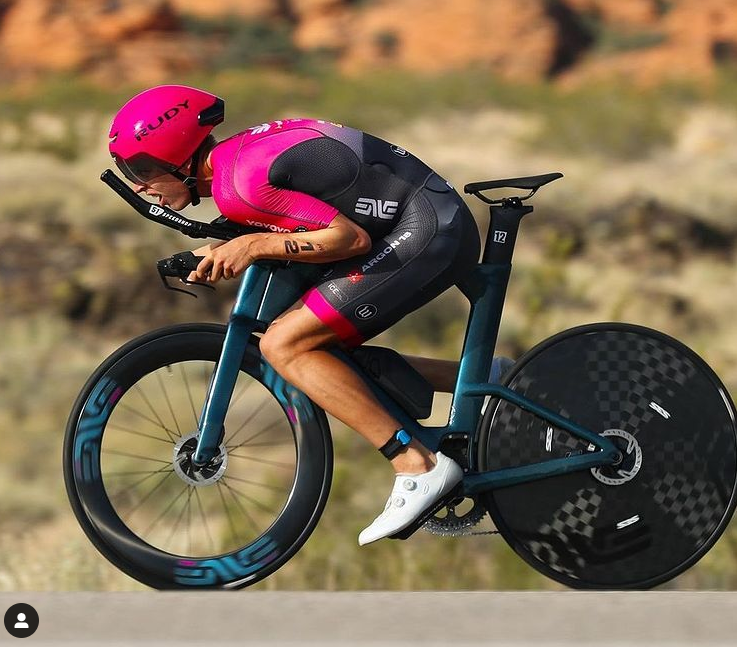Over the past weekend the 70.3 World Championships took place in Utah, USA. The location of St George is relevant as the course had both elevation, and a modest altitude of 800m. There was 1000m of climbing in the course. Much of this climbing came in the back half of the race courtesy of the Snow Canyon climb. This 10km section starts at around the 65km mark. Then follows almost 400m of elevation, with the final 2km kicking up to a 7% gradient.
Thanks to second placed finisher Sam Long for sharing his cycling power data on Strava. Sam is a great athlete to follow on Strava, as he regularly shares lots of training data and insights. So let’s have a look at the file and see what insights there might be for other athletes.
- Distance: 89.3km
- Elevation: 1086m (that’s lumpy)
- Time: less than 2 hours! A group of the leading pro men came in at just under the 2 hour mark and Sam was in that ‘group’.
- Average speed: 44.7kph
So what is of interest:
Cadence – the average cadence was 85. Cadence is a very individual thing for both cyclists and triathletes. The key thing is to have an awareness of how you ride in terms of cadence, and producing power. The mid 80s is a ‘sweet spot’ for many triathletes. There is enough tension to generate power, but not too much to tire the legs. It’s a Goldilocks thing. Beware of thinking that there is one cadence that is right for all triathletes. Because there is not. You need to experiment in training to find out what this sweet spot is for you.
Interestingly, even up the climb, Sam rode at a reasonable cadence. The main section of the climb took him 17 mins and his average cadence was 77. He held this cadence even on the really steep section for the last 2kms.This would have been in order to protect his legs for the upcoming run.
Intensity – so what intensity did he ride the course at relative to his FTP? His declared FTP in Strava is 385W on a body weight of 78.5kg (4.9W/kg). By way of reference, the very best pro cyclists are in the range of 6W/kg. The difference with world class triathletes is that they can hold a high percentage of this for an extended period of time. In Sam’s case he rode the 2 hours at an Intensity Factor of 0.91. That is a normalized power of 352W (352/385 = 0.91).
This is well above the levels that age group triathletes can hold. Most age groupers will ride a half ironman at 80-85% of their FTP. So not only is the elite athlete’s FTP higher, but they can also hold a higher percentage of this for longer.
Variability
What Sam did really well in this race was ‘even out the bumps’. The Variability Index was 1.06, which is pretty low for 1000m of elevation. So he controlled the sections where he was going uphill and rode a little harder, but it was not a huge surge. For example, the 17 mins of the climb was ridden at 378W (intensity of 0.98). The descent down the other side was ridden at a normalized power of 316W which is pretty good considering it went for 10 minutes at more than 60km an hour (intensity of 0.82). Remember this is a 3% downhill gradient and he is still pushing an IF of 0.82! This is higher than most age groupers do on the flat. Sam kindly provided some context to this on his IG. He was 40 seconds behind the main group of about 10 guys and wanted to start the run with them. So he was surging to 400-600W, then supertucking as in the photo. Our file analysis confirms this – he did those surges 4 times on the descent.
Pacing
How did Sam pace the ride? Pretty evenly actually. There was a slight fade in the second half. Normalized power for the first half was 360W and for the second was 346W. It would have been interesting to see what heart rate was doing relative to this. But there’s no sign of a chest or arm strap in any pictures, or even a wrist HR monitor.
Take homes
- Have a plan, know what you are capable of in terms of the normalized power you can ride at
- Work out what your Goldilocks cadence is for half ironman
- Spend a lot of time in TT position riding at the intensity you plan racing at
- Even out the bumps in terms of intensity
- Name your ride on Strava ‘Go big or go home’ (like Sam did).
Photo credit – his IG, and thanks for the file share on Strava. Link to Strava file – https://www.strava.com/activities/5982024415/overview
